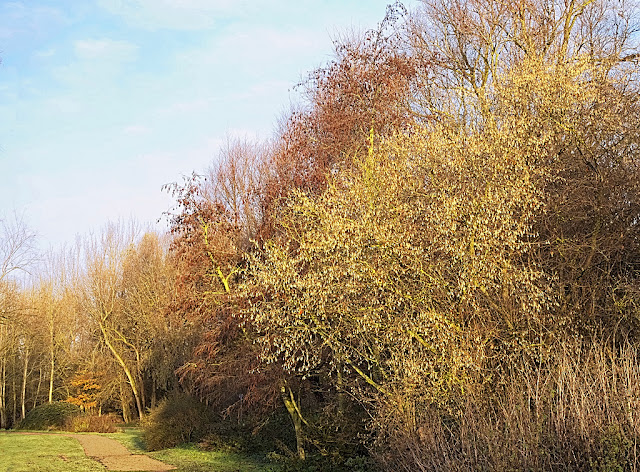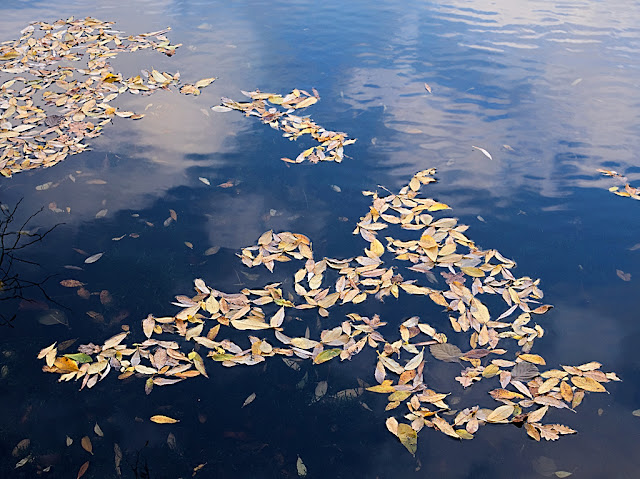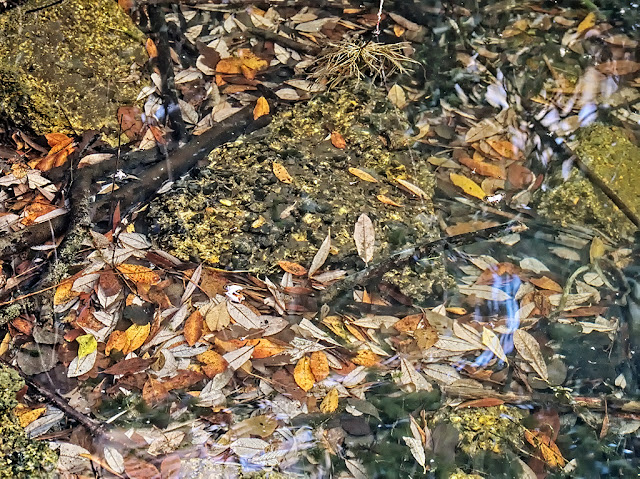 |
| The End of Autumn - 14 December 2016 The colours are autumnal, the bare trees wintry. |
There are at least three common definitions of autumn. The first, and the one I grew up with, is the astronomical definition of autumn as lasting from the autumn equinox (September 21) to the winter solstice (December 21). The second, meteorological definition, defines autumn as lasting from September 1 to November 30. The third simply asserts that autumn is the period between summer and winter.
I
like this third definition, because it is fuzzy, and natural systems
have fuzzy boundaries. I think of autumn as the time when trees lose
their leaves; plants die back; and fruit and seeds ripen and are
harvested. It is the period between the lush greens of summer
decorated with colourful flowers and the drab browns of bare earth
and branches of winter. A period of transition without any limiting
dates.
 |
| Late Fall - 22 December 2016 A single green leaf recently fallen from a hazel bush contrasts the the dark browns and blacks of the rotting leaves around. |
December, when most of the photographs in this post were taken, is clearly at the end of autumn, if not actually in winter, by any of these definitions. It also contains one of the turning points of the year: the winter solstice, after which, the days will grow longer, and eventually start to warm up.
 |
| A Touch of Spring - 11 December 2016 Bright hazel catkins, with alder catkins behind, bring a feeling of spring to the park. |
Certainly, in December 2016, there still much of the feel of autumn in Milton Country Park, but at the same time winter is beginning to appear. The reeds around the pits in are an autumnal golden brown, and there are still a few leaves left on the trees, whose mainly bare branches speak of winter. The thick carpet of dead leaves on the ground have turned from yellow to a deep rich brown darkening into black as decomposition gathers pace. In contrast, emerging hazel catkins bring a real spring-like feel to the park, especially when they sparkle in the early morning sun.
Goose Summer
 |
| Goose Summer - 1 December 2016 Fallen leaves floating on still blue water on a clear bright 'Goose Summer' day |
'Goose summer ' is an old term for spells of fine weather during autumn; the name referencing the custom of eating geese during the autumn after they had been fattened in the previous months. It was during one such spell, that I came across this mass of leaves floating on calm water. A scene that, for me, sums up such weather and that 'Goose Summer' seems the perfect title.
'Goose summer' later was contracted to 'gossamer', and eventually lost its connection to the weather, and, instead, used to refer to dew covered spider's webs which are visible on clear, cold, autumn days. But, the loss of goose summer, like its opposite 'sprat weather' (dark, damp, miserable, late autumn days when it barely gets light), leaves the English language the poorer.
 |
| Drowned Leaves - 22 December 2016 Fallen leaves decorate the roots and concrete rubble at the bottom of the lake |
As the season progresses, the floating leaves become saturated and fall to the bottom of the water where they can still be seen decorating the rubble and roots.
Brambles
 | |
| Colourful Brambles - 18 November 2016 Not necessarily noted for their contribution to autumn colours this bank of brambles presents a colourful sight |
One plant that does not immediately spring to mind when autumn colours are mentioned is the humble bramble. Yet, although, not all bushes change colour, those that do can be quite spectacular, with individual leaves turning a brilliant red that is as bright as anything that more renowned trees, such as maple, can offer.
 |
| Bramble Leaves - 11 December 2016 Some bramble leaves turn a vibrant and intense red in autumn |
Happy Christmas
This is my last post of 2016, so thank you for taking the time to read this blog, and hope you will continue to do so in 2017. Merry Christmas and a happy New Year.
Next: Last Fruit, First Shoots
No comments:
Post a Comment